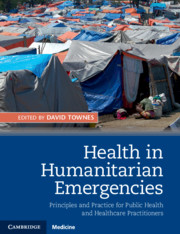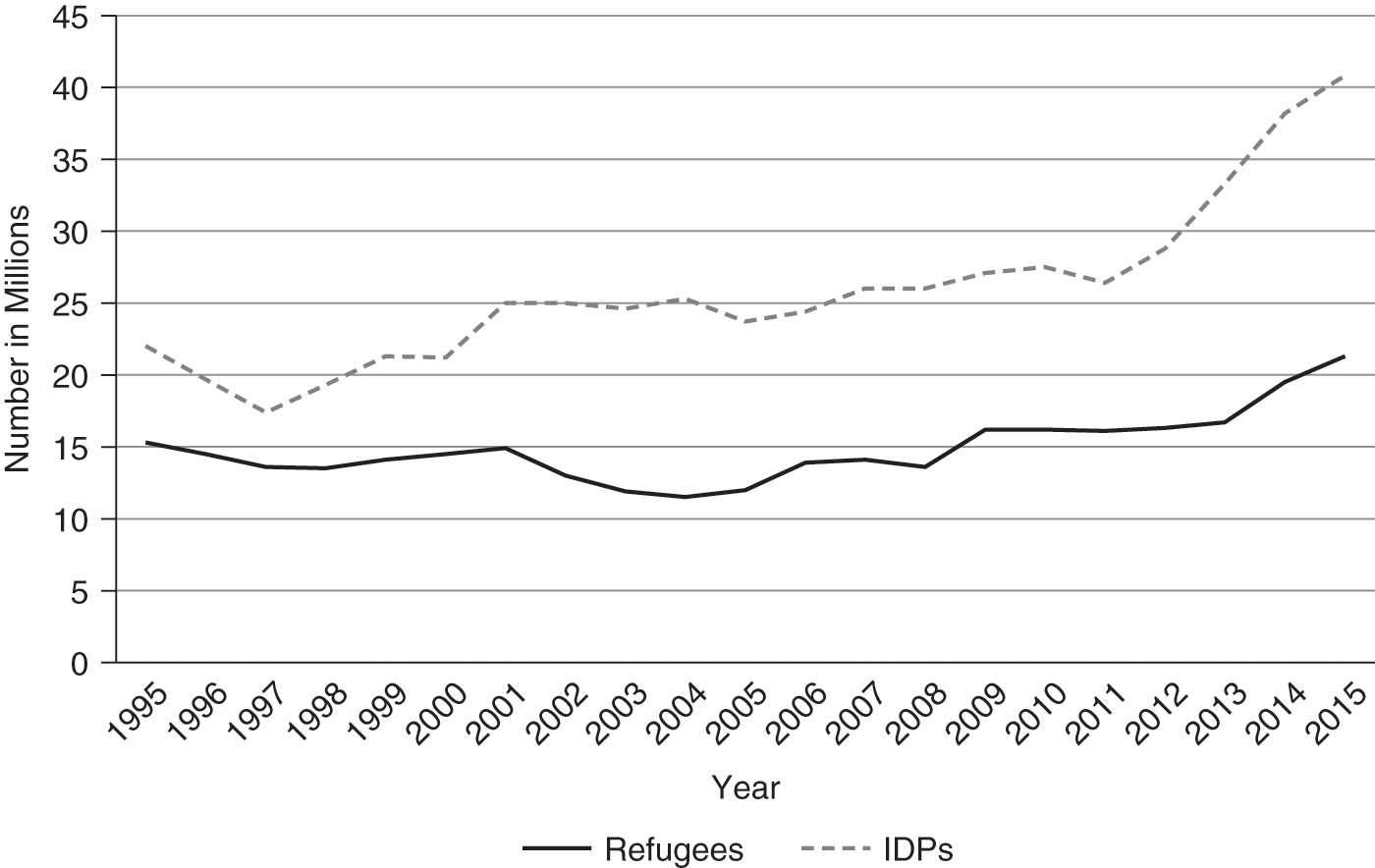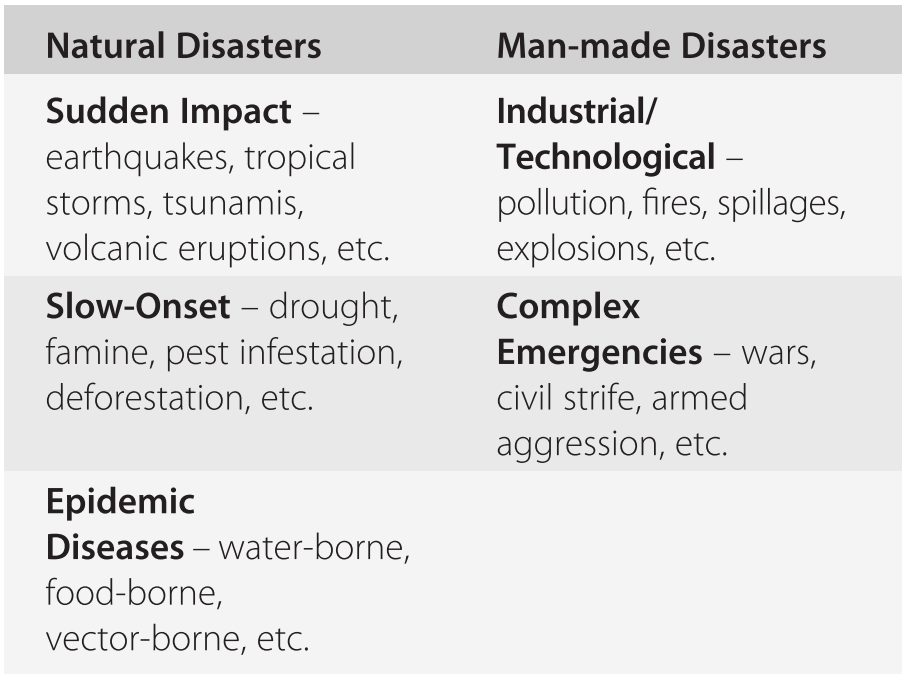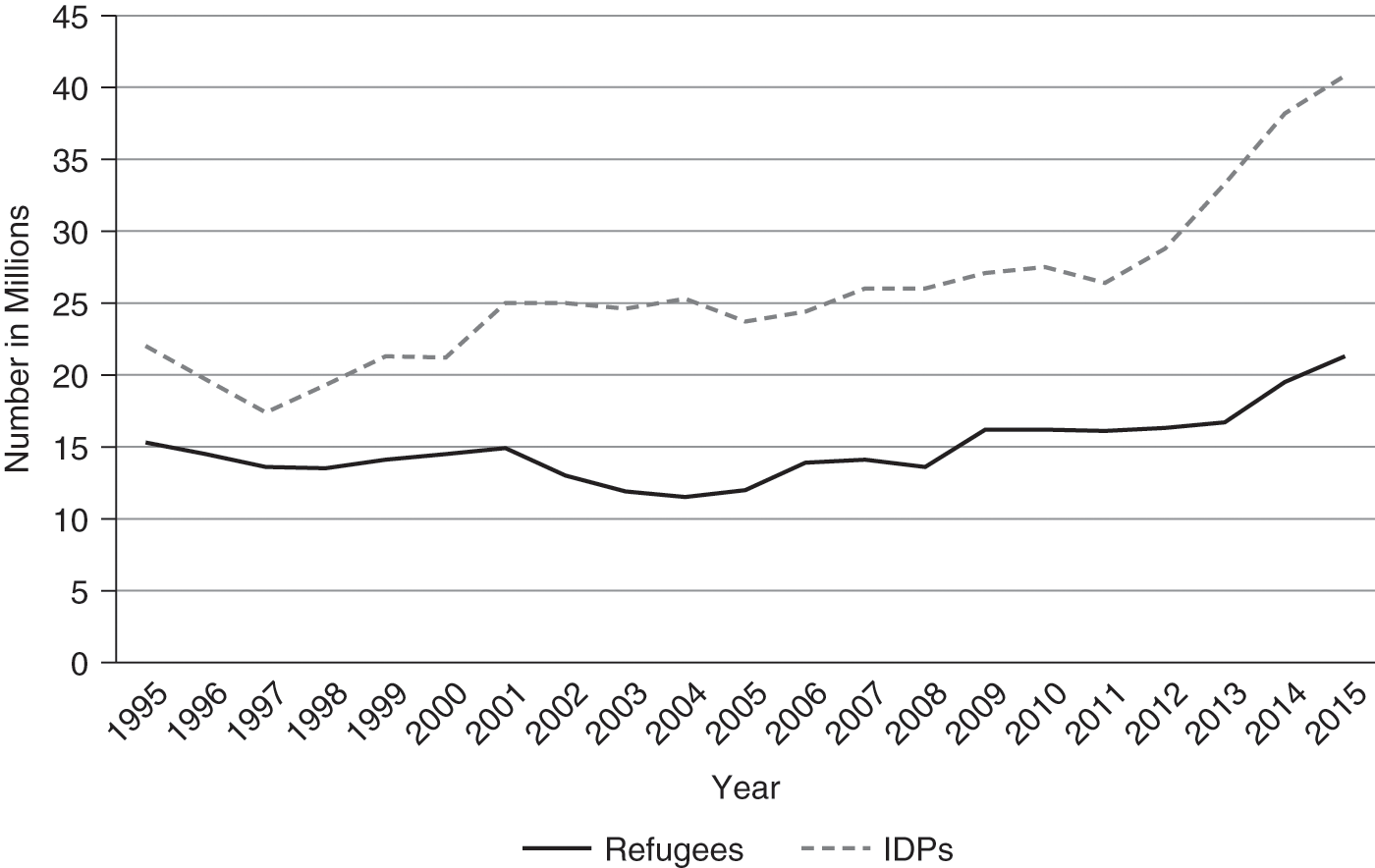Introduction
Disasters … are all too often regarded as unusual events, not part of “normal life.” In reality, however, the opposite is true. Disasters and emergencies are a fundamental part of normal life. They are consequences of the ways societies structure themselves, economically and socially; the ways that societies and states interact; and the ways that relationships between the decision makers are sustained.
Many of us perceive floods, epidemics, earthquakes, droughts, and wars as unusual events. But, the opposite is true. Rather than being rare events, disasters are common. Somewhere in the world, a disaster occurs almost daily. During the ten years between 2006–2015, there were 1,680 floods, 335 epidemics, 249 earthquakes, 179 landslides, 160 droughts, and 19 wars (Guha-Sapir et al., Reference Guha-Sapir2015; Pettersson and Wallensteen Reference Pettersson and Wallensteen2015). That is 262 disasters every year during that ten-year period.
Many of these events are small in scope, and the impact can be managed with local resources. However, some exceed the capacity of local governments, local public health systems, and local aid organizations. These are the disaster events that require international assistance. These are the events we hear about in the media: decades of war and economic hardship in Afghanistan, civil conflict and terrorism in Syria, earthquakes in Haiti, tsunamis in Indonesia, Ebola outbreaks in West Africa, and famine in Somalia. All of us would recognize the recent crises in Afghanistan, Syria, Haiti, Indonesia and West Africa as disasters. But, how do we define a disaster and distinguish humanitarian emergencies, the focus of this book, from other types of disasters?
Disasters
The United Nations Office for Disaster Risk Reduction (UNISDR) defines a disaster as (UNISDR 2009): “A serious disruption of the functioning of a society, causing widespread human, material, or environmental losses which exceed the ability of the affected society to cope using its own resources.” There are two points in this definition worth emphasizing. First, a disaster is an event disruptive enough to affect the normal function of a community. In this case, the community might be limited to the town or village affected by a defined event such as a tornado. Or, it could be an entire nation affected by armed conflict. The second point worth emphasizing in this definition is that the event is significant enough that the affected society cannot cope with the impact using its own resources. In more developed countries, the support comes from national or local organizations. In less developed countries, international support is often required, and we call these events “humanitarian emergencies.” Based on this definition, disasters and humanitarian emergencies do not occur every time a society is exposed to drought, tornadoes, wildfires, and even armed conflict (Abdallah and Burnham Reference Abdallah and Burnham2000).
The impact of disasters depends on the nature of the event and the vulnerability and preparedness of the population. Those countries prone to disasters are often highly vulnerable. Their vulnerability may be due to lack of resources, lack of preparedness, or both. These countries are often what many would consider “fragile states.” They are limited by weak governance, poor social infrastructure, and environmental degradation. All of these factors contribute to their increased vulnerability and their inability to manage the shock and stress of a disaster.
Disasters are triggered by natural forces or human-made events. Some disasters occur without warning while others develop slowly, their full impact not being felt for years. With this in mind, disasters are classified into two major categories, natural and human-made disasters, and five subcategories: sudden impact disasters, slow onset hazards, industrial/technological events, epidemics, and complex emergencies (Abdallah and Burnham Reference Abdallah and Burnham2000). This classification of disasters is shown in Table 1.1.
Table 1.1 Classification of disasters
| Natural Disasters | Man-made Disasters |
|---|---|
| Sudden Impact – earthquakes, tropical storms, tsunamis, volcanic eruptions, etc. | Industrial/Technological –pollution, fires, spillages, explosions, etc. |
| Slow-Onset – drought, famine, pest infestation, deforestation, etc. | Complex Emergencies – wars, civil strife, armed aggression, etc. |
| Epidemic Diseases – water-borne, food-borne, vector-borne, etc. |
Natural disasters include events that occur suddenly, with little warning, such as earthquakes, floods, tropical storms, tsunamis, volcanic eruptions, and landslides. These are considered sudden onset disasters. Floods are the most common natural disaster and often result in widespread food shortages and population displacement. Earthquakes, although not as common, cause the most deaths and injuries.
Many natural disasters are slow in onset. This group includes droughts, famine, environmental degradation, deforestation, and pest infestation, such as locusts. Slow onset disasters are often the result of weather conditions, which can have profound effects on marginal communities. Because of poverty and overpopulation, these marginal communities have a limited capacity to cope with adverse conditions, such as drought. So, instead of being a hardship, slow onset events like drought become a disaster, leading to famine, population displacement, and sometimes, armed conflict.
Epidemics or disease outbreaks are natural phenomena that can evolve into disasters. The outbreak of Ebola in West Africa is an example of how a society’s inability to contain an infectious disease can lead to a humanitarian emergency. Epidemic diseases can be waterborne, such as cholera; foodborne, such as dysentery; or, vectorborne, such as malaria. Some, like Ebola, are spread through person-to-person contact. Measles is an example of a common but vaccine-preventable disease that can have devastating effects on vulnerable communities. The overcrowding and poor sanitary conditions common in many marginal communities and in camps for displaced persons can promote measles outbreaks, causing many deaths.
Human-made disasters can be classified into two categories: industrial/technological disasters and complex emergencies. Pollution, chemical spills, explosions, and fires are examples of industrial/technological disasters. Inferior construction and inadequate safety procedures can trigger these events. The release of a toxic pesticide into the air of Bhopal, India caused thousands of deaths in 1984. The explosion of the Deepwater Horizon in 2010 released millions of gallons of oil into the Gulf of Mexico, resulting in a major environmental disaster. Sudden onset disasters, such as earthquakes and tsunamis, can often lead to industrial/technological disasters. An example is the destruction of the Fukushima Daiichi Nuclear Power Plant caused by an earthquake and tsunami in Japan in 2011.
Complex emergencies are the second type of human-made disaster. As their name implies, complex emergencies result from multiple factors. Many are associated with war, internal conflict, and terrorism (Abdallah and Burnham Reference Abdallah and Burnham2000). Population displacement is common in complex emergencies due to insecurity, food shortages, and destruction of services and infrastructure. We will examine the characteristics and impact of complex emergencies in more detail later in this chapter.
Humanitarian Emergencies
Any disaster, whether natural or human-made, can become a humanitarian emergency if international humanitarian assistance is needed to support the affected population. This is shown in Figure 1.1.
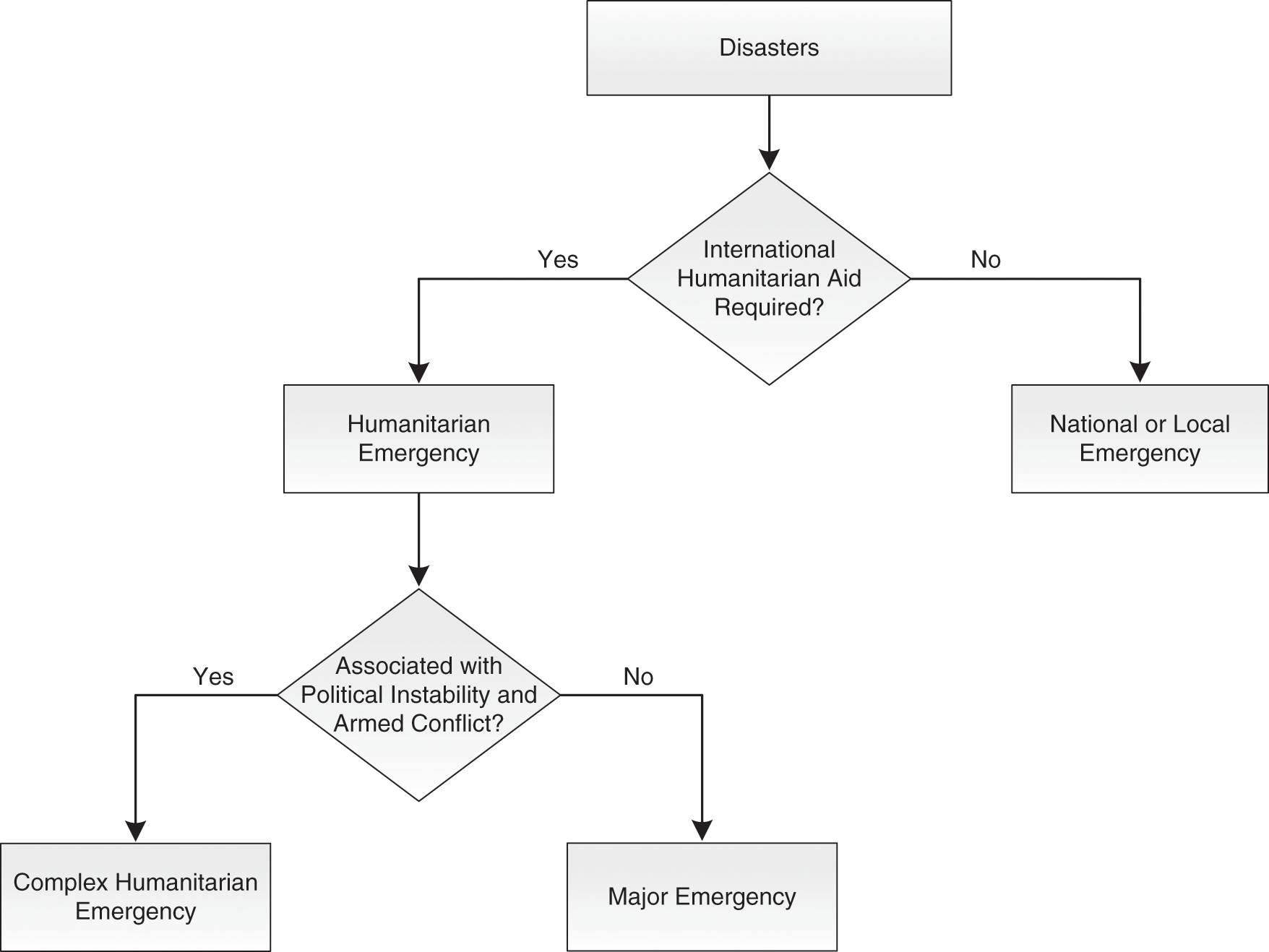
Figure 1.1 Disasters, humanitarian emergencies, and complex humanitarian emergencies
When international support is required to meet the basic needs of a population, including food, water, shelter, protection and other life-sustaining measures, it is a humanitarian emergency. For the purpose of this text, a humanitarian emergency may be defined as:
A disaster requiring international support (humanitarian assistance) to meet the basic needs of the affected population
Examples of humanitarian emergencies include the famine in the Sahel region of Africa, where international humanitarian relief organizations established feeding programs and the earthquake in Haiti that required large-scale international assistance.
In a humanitarian emergency, local and national resources cannot meet the relief needs without international humanitarian aid/assistance. Often, the scope of the disaster response is beyond the capacity of any single humanitarian agency. Humanitarian emergencies can be divided into two general categories. The first is what the Inter-Agency Standing Committee (IASC) defines as a “major emergency” shown in Figure 1.1. For the IASC, a major emergency is “any situation where humanitarian needs are of a sufficiently large scale and complexity that significant external assistance and resources are required, and where a multi-sectoral response is needed with the engagement of a wide range of international humanitarian actors” (IASC 2007).
Major emergencies typically are not politically motivated, and there are no political or conflict-related restrictions to humanitarian access. However, there is a subgroup of humanitarian emergencies often associated with political instability and armed conflict; we call these “complex humanitarian emergencies” or “complex emergencies” as shown in Figure 1.1.
Phases of Humanitarian Emergencies
There are four commonly recognized phases of a humanitarian emergency. These phases are typically pictured as a continuum, with one phase leading into another. The reality is less clear. There is an ebb and flow within the emergency continuum, but it is still helpful to describe the unique aspects of these four phases, because recognizing the transition from one phase to another can help predict needs and plan resources. This continuum is also referred to as the Disaster Risk Management Cycle that is discussed briefly in Chapter 4.
Pre-emergency Phase
The first phase of the emergency continuum is the “preemergency phase.” This is the period before disaster strikes when planning and preparedness should be emphasized. It is a time to assess the potential risks that a community may face and develop appropriate plans to respond to these risks. Stockpiling supplies, identifying shelters, planning evacuation routes, and developing incident management systems are some of the activities that should be undertaken during the preemergency phase. However, many resource-poor settings do not have the capacity for this type of planning and preparedness. As a result, many disaster events that occur in these settings evolve into humanitarian emergencies.
Acute Emergency Phase
The “Acute Emergency Phase” begins immediately after disaster strikes. This phase is often distinguished by population movement. During this phase, humanitarian organizations begin to respond, focusing on providing critical services such as food, water, sanitation, primary healthcare, and shelter. The priority during this phase is to keep the population alive (Abdallah and Burnham Reference Abdallah and Burnham2000).
Epidemiologists measure the severity of a humanitarian emergency by assessing the crude mortality rate (CMR) in the affected population. In an emergency setting, the CMR is expressed as the number of deaths per 10,000 persons per day. A doubling of the CMR from its baseline rate is considered the threshold for defining the acute emergency phase of a disaster. In the acute emergency phase, the CMR can be extraordinarily high. During the first months of the Rwandan crisis in 1994, as refugees streamed into what was then eastern Zaire, the CMR was 40 to 60 times the baseline rate for that population (Anon 1995).
Post-emergency Phase
As the population movement slows and the CMR returns to its baseline rate, a disaster enters what is called the “postemergency phase.” During this phase, aid organizations turn their focus to providing more routine services and developing local capacity to support the needs of the affected population. Displaced populations begin to consider their long-term options, such as whether to return home, integrate into the local community, or relocate to a third country.
Recovery Phase
In the final phase, the “recovery phase,” the focus shifts from emergency response to recovery and development. International relief organizations often leave during this phase. Development agencies take a more prominent role, and the responsibility for providing assistance is turned over to local authorities.
Population Displacement
Humanitarian emergencies, particularly complex emergencies, are often associated with population displacement. In a humanitarian emergency, people may be forced to move from their homes to find food, shelter or security. Those that must flee in the midst of a crisis are often the most vulnerable. They are often the poorest; those with sufficient income can leave early in a protracted crisis. In many humanitarian emergency situations, the majority of the displaced population are women, children, and the elderly. They are frequently malnourished and in poor health. Many are unaccompanied children or pregnant and lactating women. These characteristics contribute to many of the health issues discussed in this book and, as we will discuss in the following paragraphs, add to the “complexity” of complex emergencies.
When a person is displaced from his/her home, the journey from a place of insecurity can be the most taxing. The risk of death appears to be highest as displaced people travel to a place of safety. Reported crude mortality rates among Somali refugees in 2011 were more than twice as high during their journey than before they departed (CDC 2011). As mentioned, children and the elderly are at particular risk; most deaths among displaced populations occur in children less than five years of age. As shown in Figure 1.2 approximately 18 percent of Kurdish refugees in northern Iraq were under five years of age. However, 64 percent of all deaths were among this same age group (Anon 1991).
Most displaced persons are refugees or internally displaced persons (IDPs). Refugees flee their home out of fear of persecution for reasons of race, religion, nationality, membership in a particular social group, or political opinion. During their flight, refugees cross an international border seeking protection. Because they cross an international border, refugees are granted certain protections as defined by the Geneva Conventions and Added Protocols. Signatories of the Conventions must grant asylum to refugees within their territory. As described in Chapter 3, the United Nations High Commissioner for Refugees (UNHCR) is responsible for protecting the rights of refugees and ensuring that they are treated according to internationally recognized standards. With the onset of the crisis in Syria, the number of refugees has increased dramatically in recent years as shown in Figure 1.3. In 2015, 21.3 million people were considered refugees; over half were under the age of 18 (UNHCR 2016).
By the end of 2015, an unprecedented 65.3 million people were forcibly displaced because of persecution, conflict, violence, or human rights violations. This is an increase of 5.8 million people from the previous year. If all the displaced persons in the world represented a single nation, it would be the 21st largest in the world (UNHCR 2016).
As shown in Figure 1.3, most of the displaced persons in the world are internally displaced (IDPs). There were 40.8 million IDPs in 2015. IDPs flee their homes for the same reasons as refugees, but they do not cross an international border, remaining instead within the boundaries of their country. Because of this, they do not have the same legal status as refugees and, until recently, were not provided the same level of protection and assistance as refugees. Since 2006, UNHCR has assumed more responsibility for IDPs and is now assisting more IDPs than refugees (UNHCR 2016).
Complex Humanitarian Emergencies
Complex emergencies, sometimes called complex humanitarian emergencies, are a relatively recent concept in the humanitarian community. The term was introduced in the late 1980s to describe some of the humanitarian crises occurring in Africa. Through the 1990s, the term found common usage among various aid organizations, including the United Nations. Several influential academics also adopted and wrote about the term complex emergencies. In one such article called “Complex Emergencies and the Crisis of Developmentalism” complex emergencies are described (Duffield Reference Duffield1994): “For the UN, a complex emergency is a major humanitarian crisis of a multi-causal nature that requires a system-wide response. Commonly, a long-term combination of political, conflict and peacekeeping factors is also involved.” Several aspects of this definition are important to highlight. First, a complex emergency (CE) is a humanitarian emergency caused by multiple factors. There is often a political context to complex emergencies, frequently armed conflict, war, and civil strife in particular. Finally, as in other humanitarian emergencies, a large-scale or “system-wide” humanitarian response is needed.
As we mentioned earlier in this chapter, complex emergencies are often viewed as “human-made” disasters. This distinction is attributed to the multi-causal nature of CEs, as opposed to natural disasters, which are often seen as having only one cause (Duffield Reference Duffield1994). The reality however, is not as simple; many natural disasters, such as droughts and floods, are complex events with multiple social and ecologic causes (Duffield Reference Duffield1994). And, CEs are not solely “human-made” events. Natural disasters can trigger the political instability that leads to armed conflict and CEs. Nearly 90 percent of the 30 largest CEs during the past decade were associated with a natural disaster (Spiegel et al. Reference Spiegel2007).
What truly distinguishes complex emergencies from natural disasters is their “singular ability to erode or destroy the cultural, civil, political and economic integrity of established societies” (Duffield Reference Duffield1994). CEs are events where social, political, and economic systems are attacked. Even the humanitarian assistance provided in response to a CE may become a target of political misappropriation or direct violence. Complex emergencies are different from natural disasters. However, the distinction is due to the impact of a CE rather than what causes a CE (Duffield Reference Duffield1994).
In 1994, the Interagency Standing Committee (IASC), established in 1992 to coordinate humanitarian assistance among key UN and non-governmental organization (NGO) humanitarian partners, published a formal definition of the complex emergency. The IASC definition of complex emergency has since been recognized by the UN Office for the Coordination of Humanitarian Affairs (OCHA) and published in their Orientation Handbook on Complex Emergencies.
According to the OCHA Handbook, a complex emergency is defined as (OCHA 1999):
A humanitarian crisis in a country, region or society where there is total or considerable breakdown of authority resulting from internal or external conflict and which requires an international response that goes beyond the mandate or capacity of any single agency and/or the ongoing United Nations country program.
According to the OCHA Handbook, complex emergencies share several characteristics, including:
Extensive violence and loss of life; massive displacements of people; widespread damage to societies and economies;
The need for large-scale, multifaceted humanitarian assistance;
The hindrance or prevention of humanitarian assistance by political and military constraints;
Significant security risks for humanitarian relief workers in some areas.
Complex Emergencies and Armed Conflict
The OCHA Handbook, as reflected in this quote from Sergio Vieira de Mello, then the UN Under-Secretary-General and Emergency Relief Coordinator, emphasizes the uniqueness of complex emergencies and highlights their connection with the changing nature of armed conflict (OCHA 1999):
Contemporary armed conflict is seldom conducted on a clearly defined battlefield, by conventional armies confronting each other. Today’s warfare often takes place in cities and villages, with civilians as the preferred targets, the propagation of terror as the premeditated tactic, and the physical elimination or mass displacement of certain categories of populations as the overarching strategy. The acts of warring parties in recent conflicts in the former Yugoslavia, Sierra Leone and Afghanistan bear testimony to this. Breaches of human rights and humanitarian law, including mutilation, rape, forced displacement, denial of the right to food and medicines, diversion of aid, and attacks on medical personnel and hospitals are no longer inevitable by-products of war. They have become the means to achieve a strategic goal. As a result, even low intensity conflicts generate enormous human suffering. Humanitarian needs are disproportionate to the scale of military conflict. Meeting these needs has become more difficult, as the dividing line between soldiers and civilians has grown blurred.
Since 1946, there has been an overall increase in the number of internal armed conflict events each year. As shown in Figure 1.4, the number of events peaked in 1993. Between 1990 and 2015, there were 160 armed conflicts worldwide. Ninety-one percent of these conflicts were primarily or exclusively internal (Pettersson and Wallensteen Reference Pettersson and Wallensteen2015). This shift in the nature of armed conflict is tied to an overall increase in war-related injury among civilians. In recent years, the proportion of war-related deaths among civilians has ranged between 35% and 65% (Meddings Reference Meddings2001). Some authors put the number much higher, estimating that 90 percent of all conflict-related deaths occur among civilians (Ahlström and Nordquist Reference Ahlström and Nordquist1991, OCHA 1999).
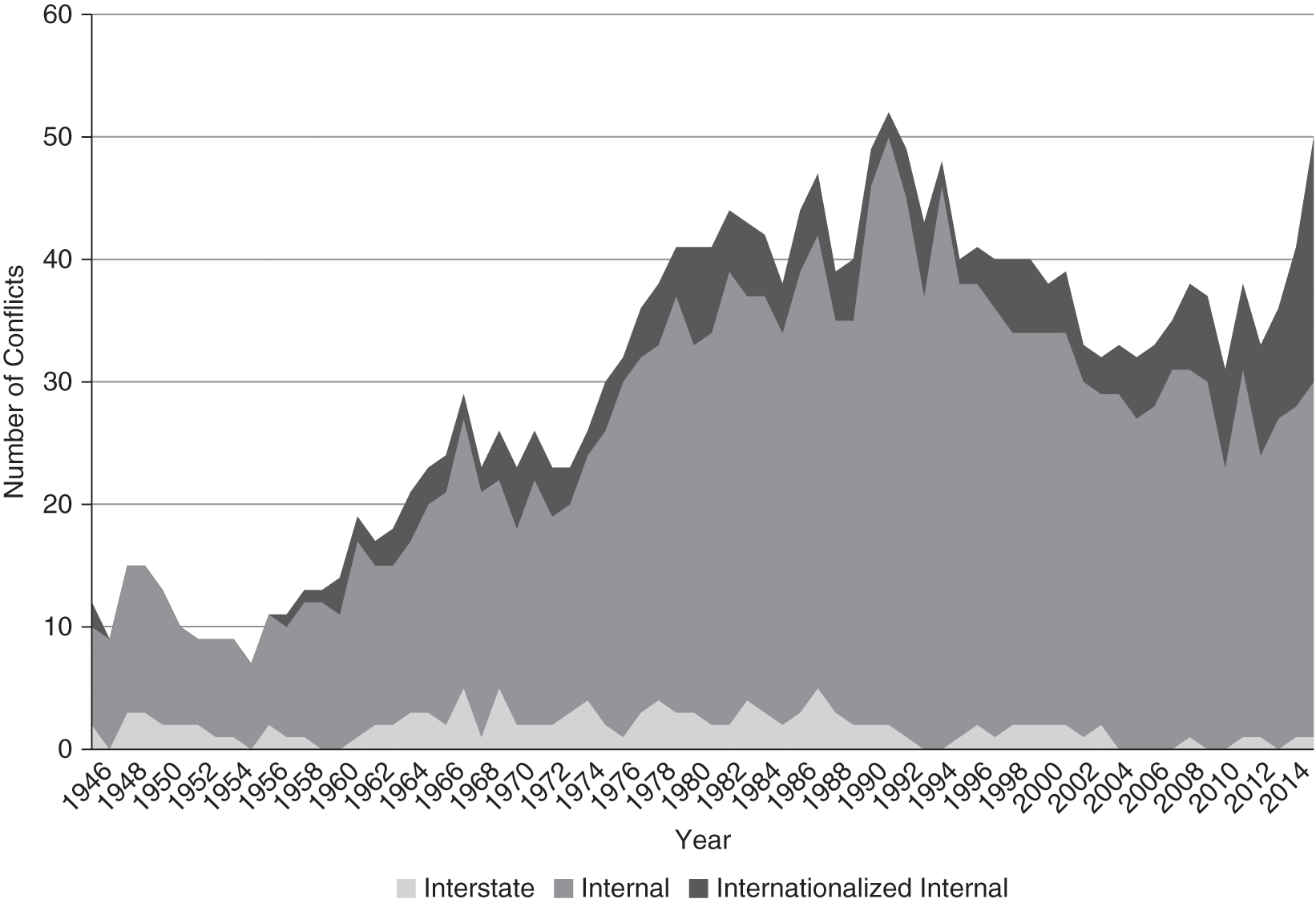
Figure 1.4 Active conflicts by type and year – 1946–2015
The political nature of internal armed conflict has also changed since the end of the Cold War. Politically driven conflict declined in East Asia and Latin America but increased in Africa, the Middle East, Eastern Europe, the Caucasus, and Central Asia. Between 1999 to 2015, nearly half (48.5%) of armed conflicts occurred in Africa and the Middle East. Armed conflicts are no longer driven by nationalist or socialist ideology. Instead, they are “resource wars that lack a clear social program” (Duffield Reference Duffield1994). Today, armed conflict is driven by social, economic, and ethnic grievances. The political, social, and economic factors associated with CEs can lead to profound suffering for the civilian populations affected.
Although complex emergencies are often associated with armed conflict, their complexity can also be attributed to multiple factors that can trigger a CE. These factors can be political, economic, social or cultural, and any of them can initiate a chain of events that ultimately leads to a CE. For instance, political insecurity weakens already fragile states, driving many to civil conflict. As the conflict escalates, civilian populations are displaced from their homes in search of food, water, shelter, and security. The social fabric that holds communities together breaks down as more people are displaced. Community support systems are disrupted and vulnerable populations like children, adolescents, women, and the elderly suffer. Ethnic and religious factors may be exploited because of political instability and limited resources. Discrimination and ethnic hostilities may result in certain groups being denied services or targeted for violence; both are common factors leading to armed conflict. Overpopulation can be either a trigger or an outcome of the displacement common in CEs. More people competing for limited resources can worsen food deficits, raise prices on limited commodities, and lead to economic collapse, which further weakens a fragile government.
The point is that complex emergencies are often associated with a combination of factors, primarily (but not exclusively) armed conflict. Some of these factors may have developed quickly; others may have been developing for years. Some may have triggered the chain of events leading to a CE, while others may be outcomes that further exacerbate the situation. Regardless of the specific trigger or outcome, what truly distinguishes complex emergencies from other humanitarian emergencies is the human toll they exact.
Conclusion
The role of health professionals in humanitarian emergencies is to address this human toll, specifically to mitigate the impact on human health. Whether by addressing the direct threats of violent injury or the indirect threats of disease and malnutrition, the goal of public health is to reduce mortality and morbidity in humanitarian emergencies. And, that too is the purpose of this book.



